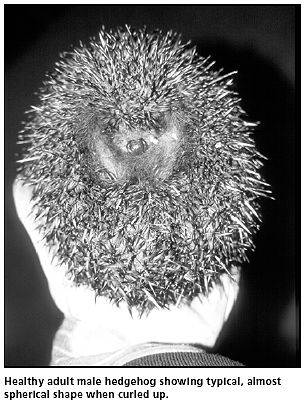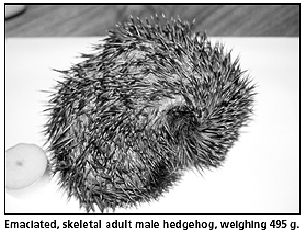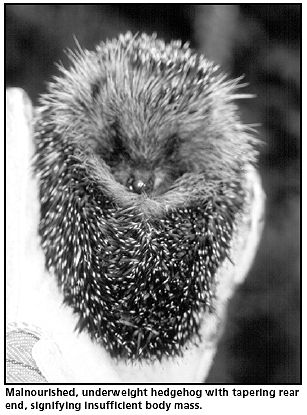|
Paper by Toni Bunnell PhD
Abstract The data suggest that it is the relationship between the weight and size of a British hedgehog (Erinaceus europaeus) rather than the weight per se, that is important for assessing the animal's nutritional status and chances of post-release survival. The relationship between two girth measurements, made at right angles to each other on a tightly curled hedgehog, provides an effective new index (Bunnell Index, BI). A minimum value of 0.80 for the BI should be obtained in a healthy animal. By reference to charts depicting values for weight and BI values recorded for 57 hedgehogs, a comparison can be made with BI values measured in sick animals presenting for treatment. This can suggest the level of treatment required in order to successfully rehabilitate an animal. Introduction British hedgehogs (Erinaceus europaeus) are reported to be declining in numbers (The Mammal Society 1999). This is partly due to road traffic kills (Stocker 1987, Kristiansson 1990, Morris et al.1993, Morris and Warwick 1994, Reeve 1998, Reeve and Huijser 1999, Huijser 1999). However, Morris (1997) conducted one study where 13 rehabilitated juvenile hedgehogs were released back to the wild and found that none were killed by road traffic. This finding could be explained if the release area was situated away from busy roads. Additional factors that could be contributing to the decline include increased fragmentation of habitat, resulting in animals tending to be more exposed to road traffic, and reduced areas for suitable nest building. Many wildlife sanctuaries exist throughout Britain, and thousands of hedgehog casualties are rehabilitated and returned to the wild. Studies carried out by Morris et al. (1993) and Morris and Warwick (1994), monitoring the progress of released rehabilitated adult hedgehogs, concluded that they probably cope well with release. One aspect of hedgehog physiology that has come under scrutiny (Morris 1984) is the minimum weight necessary for a hedgehog to survive the winter in Britain. The figure estimated as the threshold body size for winter survival is 450 g (Morris 1984). This figure was arrived at by informed guesswork, whereby the weights of hedgehogs surviving hibernation were used to calculate the probable weight necessary to survive the winter, assuming that only 25% weight loss occurs (Morris 1984). Morris determined that any hedgehog weighing less than 400 g before commencing hibernation would not be expected to survive until March–April the following year. He comments that this figure is a minimal estimate and should perhaps be raised to 450 g to allow for particularly adverse conditions. Based on previous work, the main consideration for deciding when to release a healthy, rehabilitated hedgehog back to the wild appears to be the weight of the animal in question. “Healthy” in this instance means that the hedgehog has no open wounds, no pathological symptoms attributable to gastrointestinal parasites, bacterial or protozoan infection, no skin infestations, and no ectoparasites. Faecal analysis should reveal a parasite burden within normal, non-pathological, levels and a balanced gut flora should be evident. Blood analysis would provide a more detailed picture of the health status of an animal and possibly reveal underlying sub-clinical disease. However, apart from the cost, this would cause unnecessary suffering to the majority of animals where such a procedure is not necessary, and would therefore not justify the application of the procedure. However, although weight per se is obviously an important criterion, other considerations may be even more critical. This article describes a simple index of condition that should also be taken into account. Material and Methods The hedgehog generally presents for clinical examination as a tightly curled ball covered in sharp, impenetrable spines. This does not lend itself to easy examination. When the animal produces some droppings these can be examined either microscopically or by overt appearance (Bunnell 2001b). Data for this study were collected from all hedgehogs (n = 57) arriving at the author's sanctuary in York, England, between June 2000 and December 2000. (A total of 77 animals arrived throughout the year 2000.) The sanctuary is run under the supervision of the Royal Society for the Prevention of Cruelty to Animals (RSPCA). The arrival at the sanctuary of many hedgehogs weighing 700 g or more, but extremely thin with protruding ribs, suggested that the proposed minimum winter survival weight of 450 g (Morris 1984) was inaccurate. It seemed that weight per se was an inadequate method for assessing hedgehog health and, therefore, suitability for release. The author decided to develop a procedure that would produce objective data, which would reliably indicate the condition of an animal with regard to nutritional status. This method involves taking measurements of a hedgehog when tightly curled up, determining an index (Bunnell Index, BI) from the data, and comparing this with data that indicate whether the index falls within a satisfactory range. The procedure can be conducted immediately on arrival of any hedgehog casualty, and can be used to assess the state of malnutrition, if it exists, by determining the BI. The technique is simple and quick. Two measurements are taken using a standard non-stretchable tape measure, with the animal on a non-slip surface. One measurement is taken round the middle of the animal to cross at the point where the nose ends (“A,” latitudinal circumference). The other measurement, using a second tape measure already secured underneath the animal, is taken round the hedgehog from head to tail (“B,” longitudinal circumference). Care must be taken with both measurements to ensure that the ends of the tape measure meet easily without altering the shape/positioning of the hedgehog. When obtaining measurement A, the positioning of the tape measure is crucial; a measurement taken lower down toward the tail can result in a lower (inaccurate) reading. Repeatedly measuring many hedgehogs over several consecutive days demonstrated consistent BI values and hence the reliability of the method. A is divided by B to give a value for the BI. It is important to determine the BI value to two decimal places (i.e., a value of 0.794, becomes 0.79, while a value of 0.805 becomes 0.81).
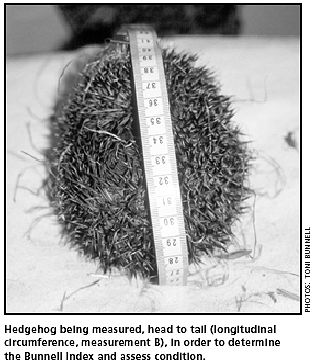 It is also important that the animal is tightly curled; an animal that is relaxing out of this state will lead to inaccurate measurements being taken. Measurement B will be greater and measurement A smaller when a hedgehog is relaxed compared with when it is tightly curled, thus giving rise to a lower BI than is actually the case. With the exception of very sick or injured hedgehogs, all hedgehogs tend to curl tightly, so this does not present a problem. Variation in spine length between hedgehogs will not affect the BI value for individual animals. A hedgehog with relatively long spines, compared with another, will be uniformly covered with these spines and thus the BI value should still accurately portray the nutritional state of the animal. Between June and December 2000, all hedgehogs (n = 57) brought to the sanctuary in need of care were assessed on arrival and monitored closely during their stay, this including daily examination and weight measurements. They were also measured to provide a BI value. Only, when an animal was too poorly to be subjected to being measured, or too small to provide an accurate measurement due to an inability to curl up tightly (as with some nestlings), was the procedure for obtaining the BI omitted. (“Nestlings”, in this instance, includes all animals with a weight less than 250 g.) In order to obtain values for the BI for healthy animals during development, all animals in a litter of eight were weighed on a daily basis from 26–54 days old and the BI recorded at regular intervals. It has always been the practice at the sanctuary to weigh all animals daily to monitor their progress. The additional BI measurements helped to give a fuller picture of the state of health for each animal. By recording the weight and BI of this litter, it was possible to produce a chart depicting the normal weights and BI measurements of a hedgehog between 26 and 54 days old. The ability of a number of hedgehogs (n = 25) to survive cold weather was recorded in those rehabilitated hedgehogs deemed unsuitable for return to the wild prior to or during the winter months. These animals were kept in conditions most suited to their state of health and weight. Some were released into an enclosed private garden, some kept in a heated unit, and some kept indoors. All animals received unlimited food and water and were weighed at regular intervals to ensure that they were making good progress. In addition, their BI was determined at regular intervals. If, at any time, those animals living in the garden were found to be losing weight, they were transferred to the heated unit, and given medication (wormer/antibiotics) where necessary (Bunnell 2001b). The minimum overnight temperatures for outdoors and the heated unit were monitored on a daily basis, bearing in mind that in the UK external air temperature can vary greatly over a day or night. The data collected provided much information regarding the ability of hedgehogs to survive low temperatures when food was freely available and housing and nest materials were optimal. When considering the release of an animal, having determined the BI, other factors were then taken into account, including recent rate of weight gain, age of the animal, the time of year, external temperature, and current weather conditions at the time of the proposed release. For example, if an animal had been exposed to external temperatures for at least a week; had continued to gain weight during this time; had reached a weight of 650 g or more prior to the onset of winter; and achieved a minimum BI value of 0.80, it was considered to be a suitable candidate for release. Results
Table 1 shows a range of weights and BI readings in eight healthy hedgehog siblings, ranging from 26-54 days old. The BI values for individual animals range from 0.78-0.88, while the values averaged for all eight animals, on the eight occasions they were measured, range from 0.80-0.83. These values can be taken as being within a range compatible with that seen in normal wild British hedgehogs, as the animals that provided these data were not ailing in any way, merely orphaned prior to weaning. As a result they did not need any medication, merely warmth and food. The data shown in Table 1 could be used to help assess all nestlings on arrival and determine their age and nutritional status for any particular weight. It can be seen that the minimum BI was 0.80. The BI of an underweight animal will be lower than 0.80, and thus it will be assessed as malnourished and of indeterminate age. The assessment of an animal as being underweight is made on the basis of the presence of protruding ribs and a pointed rear end (Stocker 1987, Sykes and Durrant 1995). The tendency of the average BI values to remain almost constant as the average weight for all eight siblings increases is seen in Figure 1.
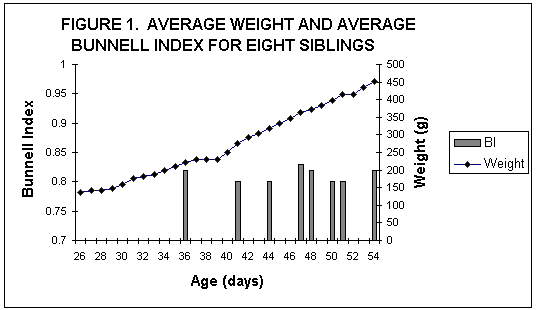 The monitoring of hedgehogs in this study took place in an enclosed private garden with supplementary food made available, in addition to the “wild diet” of natural food existing in the garden. It is speculated that those animals that continued to gain weight over a period of a week or more, and achieved a BI of at least 0.80, were good candidates for release. In order to test the idea that a minimum BI is necessary for a hedgehog to survive external temperatures while demonstrating a continuous weight gain, the BI data for survivors and non-survivors were examined in 28 animals arriving for treatment between June–October 2000. The BI values were determined on arrival and the eventual outcome of all individuals recorded. Of 16 hedgehogs with a BI less than 0.80, only five survived to release status (31%) (Figure 2). However, of 12 animals whose BI measured 0.80 or above on arrival, 10 survived to release status (83%).
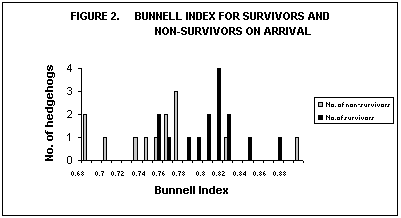 These findings, accompanied by direct observation that animals with a lower than 0.80 BI value were thin in appearance with protruding ribs, suggest that a BI of 0.80 is a threshold point above which animals have an increased chance of survival compared with animals displaying a BI less than 0.80 (Figure 2). Testing the null hypothesis that the median indices for live (0.81) versus dead (0.76) animals are the same, using the non-parametric Mann-Whitney test, gives a P-value of 0.011. This shows that there is a statistically significant difference in survival rates between animals with a BI of 0.81 and those with a BI of 0.76, those with the higher BI on arrival for treatment being more likely to survive to release status. The survivors had, on average, a significantly higher BI than those animals that died. As all hedgehogs were monitored on a regular basis, it was possible to determine the weights, BI, and minimum outdoor temperatures at which hedgehogs of different ages failed to sustain or increase their weight. Table 2 illustrates the external temperature and weight for a number of animals that were seen to lose weight during the following 24 hours and had to be moved to a warmer environment. For instance, Animal C weighing 455 g, with a BI of 0.82, was unable to maintain its weight at 9ºC. Animal A weighing 425 g with a BI of 0.87 at 7ºC, Animal O weighing 450 g with a BI of 0.80 at 10.5ºC, and Animal P weighing 430 g with a BI of 0.80 at 10.5ºC, failed to sustain their weight. All these hedgehogs showed further weight gain in a warmer environment and were subsequently released following further monitoring outdoors. These data illustrate that, despite a BI of 0.80 or more, hedgehogs still needed to reach a certain weight to enable them to maintain their weight at specific external temperatures. The daily provision of food was not enough to offset the demands made on underweight animals to maintain their core temperature. Table 3 gives examples of hedgehogs that continued to gain weight in the days following the recording of these data. That is, for the given values of minimum ambient temperature, body weight, and BI value, all these animals continued to thrive and were subsequently released. For instance, on 1 August 2000, a hedgehog weighing 345 g with a BI of 0.84 at 15ºC, gained weight continuously and was released at a weight of 445 g, a BI of 0.85, and a temperature of 17ºC. At a temperature of 6ºC, an animal needed to weigh 420 g or more, with a BI of at least 0.83, in order to continue to gain weight. As the minimum external temperature decreased, the weight and BI of an animal necessary for them to sustain their weight, increased. It should be mentioned again that housing and food provision was optimal, and in a private enclosed garden. Also, these animals were not hibernating and were released back to the wild when the minimum overnight temperature was several degrees above zero (6.5–17ºC), the ground was not frozen, and food was still available. Table 3 also provides some examples of weights, with associated BI values, of several animals when released at the given minimum external temperatures. It can be seen that, at a temperature of 17°C, a satisfactory BI would be 0.81 for an animal weighing 495 g, while at a temperature of 4°C, a satisfactory BI would be 0.88 for an animal weighing 650 g. Table 4 shows the numbers of animals that gained or lost weight when exposed to certain external temperatures. Between temperatures of -1°C and 3°C, nine out of 10 animals weighing less than 500 g failed to thrive (90%), while of those weighing more than 500 g, only eight out of 71 failed to thrive (11%), the remaining 63 (89%) continuing to gain weight. Some animals may have been included in this assessment more than once during the period of monitoring. It can be seen that the ability of an animal to continue to gain weight depends, amongst other things, on its weight, BI value, and the ambient temperature. Other factors that may affect weight gain include burdening by gastrointestinal parasites and pathogens (Bunnell 2001b, Bunnell 2001c), and infestation with ringworm or sarcoptic mange (Bunnell 2000) or ticks (Bunnell 2001a). The data shown in Tables 2, 3, 4, and 5, are intended as a guide to indicating suitability for release to the wild of rehabilitated hedgehogs. A threshold BI for all ages was determined to be 0.80 and applies to healthy hedgehogs during the warmer months of the year. This figure was arrived at based on data collected for 57 animals in 2000. The BI was determined for each animal and subsequent progress recorded as usual. The BI can often be higher than 0.80 in nestlings (Table 1) where the ability to maintain core temperature is partly dependent on the presence of siblings. The BI is also seen to be higher in animals building up fat reserves in readiness for hibernation. BI values in the latter tend to exceed 0.90 in the hibernating state. Table 5 shows that although the weight of an animal remains the same on the onset of hibernation, compared with immediately before hibernation, the BI increases considerably. This increase is due to even tighter curling of the hedgehog, which in turn reduces the surface area to volume ratio, reducing the surface area exposed to the elements and hence minimising heat loss. As the BI increases to the point where it approaches 1.0, the animal becomes almost spherical in shape, thus optimizing its ability to conserve heat and therefore maintain its core temperature during adverse conditions.
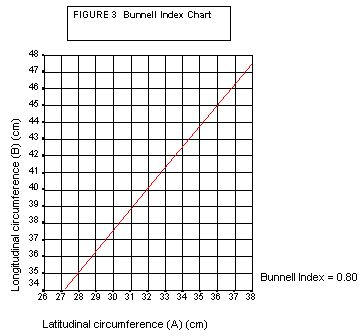
Figure 3, the Bunnell Index Chart, provides a method of assessing a hedgehog to determine if it has an adequate weight/size relationship. Table 6 is intended as a guideline for establishing what a satisfactory weight would be for an animal with a particular set of A and B BI measurements. Discussion It is commonly known that a malnourished hedgehog will present a more pointed rear end, while those that are better nourished will appear more rounded. (Stocker 1987, Sykes and Durrant 1995). However, merely observing a hedgehog for signs of malnutrition is too subjective and can lead to hedgehogs being returned to the wild with insufficient body weight to sustain them through hibernation, or to ensure survival prior to hibernation. Insufficient body weight tends to lead to, or be accompanied by, subsequent overburdening with parasites, bacteria, ticks, etc. (Bunnell 2001c), which in turn can lead to collapse and eventually death. Data collected from 168 hedgehogs between April 1998 and December 2000 demonstrated that a minimum weight of 450–500 g was not an acceptable criterion on which to base the release of rehabilitated wild hedgehogs when the onset of cold weather is imminent. Casualties kept arriving at the sanctuary with weights around 700 g, displaying typical signs of serious malnutrition (i.e., tapered rear end, concave stomach and prominent ribs easily felt when the animal was picked up with bare hands). These animals, having come straight from the wild, had not been subject to captive conditions, including unlimited access to food, and therefore the weights observed could be considered to be true values, uninfluenced by a captive feeding regime. Where BI values are seen to change over a period of time, for any particular animal, it is interesting to note the reasons why. Animal C at one point weighed 400 g with a BI of 0.81, and a week later weighed 438 g with a BI of 0.77. Examination of the BI data showed that the fall in BI was due to the animal increasing in longitudinal circumference (B), proportionately more than the latitudinal circumference (A). Based on the data shown in Figure 2 and the associated statistical findings, this animal would have a poorer chance of survival at this point, with a BI of only 0.77. Animal C subsequently continued to gain weight (585 g on release), leading to a greater value of A compared with B, and a BI value of 0.88 on release. An increase in weight tends to lead to an increase in the BI reading of an animal that is initially malnourished. However, this depends on the rate of weight gain. If the rate of weight gain is slow compared with that normally observed in hedgehogs of that size and/or age, then the BI value may fall. As the animal increases in length, with an increase in longitudinal circumference, this causes an increase in the B measurement and, at the same time, a decrease in the A measurement. As the BI is determined by dividing the A by the B measurement, this will cause a reduction in the BI. Using the criterion of weight alone a British hedgehog weighing around 450 g would, according to the literature (Morris 1984), be deemed suitable for release. It could be argued that a severely malnourished hedgehog, whatever its weight, will be easily diagnosed as such by the experienced hedgehog caregiver. However, some animals with borderline malnutrition are not easy to identify. These animals might appear to be suitable candidates for release, all other criteria having been satisfied, but in fact would have a very poor chance of survival were they to be released with a BI lower than 0.80 during mild weather. This conclusion is based on the data shown in Figure 2 and also in Tables 2 and 3, where progress of animals under external temperatures was monitored. The only difference between survival in the wild and in a private garden is the availability of food and possibly decreased exposure to the elements. As mentioned earlier, studies following the release of rehabilitated hedgehogs concluded that rehabilitated adult hedgehogs probably cope well with release (Morris et al. 1993, Morris and Warwick 1994) and, therefore, the monitoring of animals in a garden would seem to provide a reasonable indication of their survival capability in the wild. This assumption is supported by the appearance of many (marked) rehabilitated animals, close to their original release site, several months after their release (Bunnell, unpubl.). Considering the percentage of non-survivors and survivors (Figure 2), it would appear that there is a required minimum BI (in the warmer months) of 0.80. Those non-survivors with a BI less than 0.80 could not necessarily be said to have died from malnutrition. The lower BI has most probably predisposed them to an increased intestinal worm/pathogen burden. Alternatively, an increased susceptibility to increased infestation by worms and/or pathogens may have resulted in loss of appetite and/or reduced absorption and/or assimilation of food products, which in turn has resulted in weight loss and hence a lower BI. In either case the cause of a reduced BI can only be speculated upon. However, a BI less than 0.80 would certainly seem to be strongly associated with a poor prognosis and slimmer chances of survival to release status. It should be mentioned that survival rates of hedgehogs, at the sanctuary run by the author, are very high (nestlings 74%, juveniles 55%, adults 58%) (Bunnell 2001c). A recommended minimum release weight for subadult (juvenile) hedgehogs prior to the onset of winter (mid September) is 650 g (with an associated BI of 0.80 or more). This figure is based on the premise that any healthy, rehabilitated animal that has not yet reached its adult weight should, following release, continue to gain weight and reach a satisfactory hibernation weight prior to the onset of winter . Table 5 provides the BI measurements and weights observed in adult hedgehogs immediately prior to, and following the onset of, hibernation. These animals were exposed to external temperatures and only hibernated at the given weights and BI values. As the average weight of a hibernating animal, at the onset of hibernation, was 730 g (n = 15) (ranging from 635 g to 1005 g), it follows that any hedgehog released before winter needs to be a minimum weight of 650 g with associated satisfactory BI value. It is actually preferable to release animals with a minimum weight of 650 g and a BI of 0.83 or more as this will give them a better chance of surviving during temporary unavailability of food. In addition, it has been observed (Bunnell, unpubl.) that rehabilitated animals, following introduction into a new environment, in this case an enclosed private garden, initially lost weight, despite unlimited access to supplementary feeding. This behaviour was only temporary, and the animals, without exception, began to forage in the garden and consume the supplementary food within a couple of days. This quickly resulted in restoration of their initial weight and subsequent further increase to their expected adult weight. Conclusion This study has demonstrated an improved method to correctly assess whether a rehabilitated hedgehog is ready for release, or to assess its nutritional status, namely the determination of the Bunnell Index. The BI has been shown to be reliable across a range of size and weights as shown in Table 1 for hedgehogs aged 26 – 54 days. Table 6 also demonstrates consistency of the BI obtained for 26 animals ranging from 238 to 1000 g, all of these animals displaying optimum health and nutritional status. Any animal displaying a BI of 0.80 or above is suitable for release back to the wild, all other factors being considered satisfactory. For instance, a sudden fall in temperature, inclement weather conditions such as snow or heavy winds, or predicted poor weather, are reasons to delay release until the situation improves. Also, all wounds must be healed, no ticks, ringworm or mange present, droppings normal, weight gain continuing, and body weight and BI acceptable for the time of year and minimum ambient temperature. The weight is important, particularly with juveniles, as a six-week-old animal can have a BI of 0.85 but be unable to survive one cold night out in January. A minimum body weight of 650 g (with an associated BI of 0.83 or greater) is suggested for rehabilitated hedgehogs released in the autumn. Release of animals during the winter months, in temperatures lower than 5°C, is not recommended and is in contravention of the United Kingdom's Abandonment of Animals Act (1960), as directed by the Wildlife Department of the RSPCA. Animal Welfare Implications The development of the Bunnell Index for assessing the nutritional status of rehabilitated hedgehogs on arrival and prior to release is a step forward in the treatment of a species on the decline in Britain. It will have far-reaching effects by increasing survival chances of hedgehogs released back to the wild by ensuring that each animal is released at its optimum weight and nutritional status. This information needs to be incorporated into all teaching and practices currently in use at veterinary schools and wildlife sanctuaries with regard to care of the hedgehog. Acknowledgements I would like to thank Dr. Geoff Oxford, Department of Biology, University of York for invaluable help and feedback. Bibliography Bunnell, T. 2000. Tea tree antiseptic cream: A new treatment for ringworm and sarcoptic mange in the hedgehog (Erinaceus europaeus). J. Am. Holistic Vet. Med. Assn. 19(2): 29–31. Bunnell, T. 2001a. An effective, harmless treatment for tick (Ixodes hexagonus) infestation in the hedgehog (Erinaceus europaeus). J. Am. Holistic Vet. Med. Assn. 19(4): 25–26. Bunnell, T. 2001b. The importance of faecal indices in assessing gastro-intestinal parasite and pathogen infestation in the hedgehog (Erinaceus europaeus). J. Wildlife Rehab. 24(2): 13–17. Bunnell, T. 2001c. The incidence of disease and injury in displaced wild hedgehogs Erinaceus europaeus. Lutra 44(1): 1–10. Dimelow, E. J. 1963. Observations on the feeding of the hedgehog (Erinaceus europaeus L.). Proc. Zool. Soc. London 141: 291–309. Herter, K. 1965. Hedgehogs, a comprehensive study. Phoenix House. [Out of print but often available through libraries] Huijser, M. P. 1999. Human impact on populations of hedgehogs Erinaceus europaeus through traffic and changes in the landscape: A review. Lutra 42: 39–55. Kristiansson, H. 1990. Population variables and causes of mortality in a hedgehog (Erinaceus europaeus) population in southern Sweden. J. Zool. London 220: 391–404. Morris, P. A. 1984. An estimate of the minimum body weight necessary for hedgehogs (Erinaceus europaeus) to survive hibernation. J. Zool. London 203: 291–94. Morris, P. A., et al. 1993. The behaviour and survival of rehabilitated hedgehogs (Erinaceus europaeus). Animal Welfare 2: 53–66. Morris, P. A., and H. Warwick. 1994. A study of rehabilitated juvenile hedgehogs after release into the wild. Animal Welfare 3: 163–77. Morris, P. A. 1997. Released, rehabilitated hedgehogs: A follow-up study in Jersey. Animal Welfare 6: 317–27. Reeve, N. J. 1994. Hedgehogs. London: T & AD Poyser. Reeve, N.J. 1998. The survival and welfare of hedgehogs (Erinaceus europaeus) after release back into the wild. Animal Welfare, 7(2):189–202. Reeve N. J., and M. P. Huijser. 1999. Mortality records affecting wild hedgehogs: A study of records from wildlife rescue centres. Lutra 42: 7–24. Stocker, L. 1987. The complete hedgehog. London: Chatto & Windus, 1–107. Sykes, L., and J. Durrant. 1995. The natural hedgehog. London: Gaia Books. The Mammal Society. 1999. The state of British mammals. The Mammal Society: 1–4.
Toni Bunnell, Ph.D. began rehabilitating hedgehogs in 1990. Since then she has treated and cared for an increasing number of sick or injured animals, She takes 90% of the hedgehogs received by York (England) RSPCA Animal Home, releasing survivors back to the wild with an 80% success rate. Bunnell earned a Ph.D. from the Open University (Milton Keynes, England) on playful behaviour in the polecat (Mustela putorius) in relation to family group activity. She lectures full-time in biological sciences at the University of Hull, England. Her current research activities involve identifying the environmental factors that influence immune status resulting in pathological symptoms and subsequent incapacitation of hedgehogs.
The author can be contacted by email at tonibunnell2018@gmail.com |
